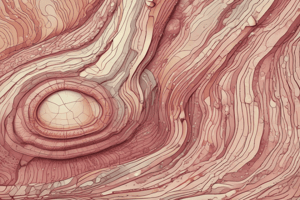Podcast
Questions and Answers
What is the function of the dermal papillae in the papillary layer?
What is the function of the dermal papillae in the papillary layer?
- To increase skin mobility
- To form finger-like projections into the epidermis (correct)
- To provide a barrier against harmful substances
- To regulate body temperature
What is the main composition of the subcutaneous tissue?
What is the main composition of the subcutaneous tissue?
- Dense irregular connective tissue
- Vascularized tissue
- Adipose tissue (correct)
- Loose connective tissue
Which skin layer is composed of dense irregular connective tissue?
Which skin layer is composed of dense irregular connective tissue?
- Epidermis
- Subcutaneous tissue
- Reticular layer (correct)
- Papillary layer
What is the function of the skin in terms of vitamin D production?
What is the function of the skin in terms of vitamin D production?
What is the function of the nerve endings in the skin?
What is the function of the nerve endings in the skin?
What is the main function of the skin and hair?
What is the main function of the skin and hair?
What is the primary function of the epidermis?
What is the primary function of the epidermis?
What is the name of the layer of skin between the stratum corneum and stratum granulosum found in the palms and soles?
What is the name of the layer of skin between the stratum corneum and stratum granulosum found in the palms and soles?
What is the purpose of the dermis?
What is the purpose of the dermis?
What is the number of layers in the epidermis?
What is the number of layers in the epidermis?
What is the source of epidermis regeneration?
What is the source of epidermis regeneration?
What is the outermost layer of the skin?
What is the outermost layer of the skin?
Study Notes
The Integumentary System: A Comprehensive Look at the Skin Layers
The integumentary system is the largest organ system in the human body, encompassing the skin and its appendages, subcutaneous tissue, deep fascia, mucocutaneous junctions, and breasts. It plays a crucial role in protecting the body from external harm, regulating body temperature, and providing sensory information to the nervous system. This article will focus on the skin layers, which are the primary components of the integumentary system.
Skin Layers
The skin is composed of three main layers: the epidermis, dermis, and subcutaneous tissue. Each layer has different functions and structures, which contribute to the overall functionality of the skin.
Epidermis
The epidermis is the outermost layer of the skin, which is continuously shedding dead skin cells. It is composed of stratified squamous epithelial cells that break down into four to five layers from superficial to deep: the stratum corneum, stratum granulosum, stratum spinosum, and stratum basale. In the palms and soles, where the skin is thicker, there is an additional layer of skin between the stratum corneum and stratum granulosum called the stratum lucidum. The epidermis regenerates from stem cells located in the basal layer that grow up towards the corneum.
Dermis
The dermis is the middle layer of the skin, which supports the epidermis and contains blood vessels, nerves, hair follicles, and sweat glands. It further subdivides into two layers: the superficial papillary dermis and the deep reticular layer. The papillary layer forms finger-like projections into the epidermis, known as dermal papillae, and consists of highly vascularized, loose connective tissue. The reticular layer is made of dense irregular connective tissue.
Subcutaneous Tissue
The subcutaneous tissue, also known as the hypodermis, is the deepest layer of the skin. It is composed of adipose tissue, which increases skin mobility, insulates the body, and acts as a shock absorber. It also contains blood vessels and nerve endings.
Functions of Skin Layers
The skin layers perform various functions that contribute to the overall health and well-being of the body.
Protection
The skin and hair provide a barrier against harmful substances, ultraviolet (UV) radiation from the sun, and temperature extremes.
Sensation
The skin contains nerve endings that detect touch, pressure, pain, heat, and cold.
Temperature Regulation
The skin can sweat and widen blood vessels to regulate body temperature.
Waste Excretion
The skin eliminates some wastes through sweat.
Vitamin D Production
When exposed to UV light from the sun, the skin produces vitamin D, which is important for bone health.
Conclusion
The integumentary system, specifically the skin layers, plays a vital role in protecting the body, regulating temperature, and providing sensory information. Understanding the structure and function of the epidermis, dermis, and subcutaneous tissue is crucial for maintaining overall health and well-being.
Studying That Suits You
Use AI to generate personalized quizzes and flashcards to suit your learning preferences.
Description
Learn about the structure and functions of the skin layers, including the epidermis, dermis, and subcutaneous tissue, and how they contribute to the overall health and well-being of the body. Understand the importance of the integumentary system in protecting the body, regulating temperature, and providing sensory information.




